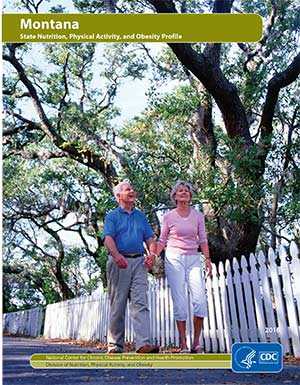Montana State Nutrition, Physical Activity, and Obesity Profile
Many American communities lack environments that could support healthy diets and regular physical activity. Healthy dietary and physical activity practices can lower the risk for heart disease, type 2 diabetes, and some cancers.1,2
In addition, excess calorie intake and physical inactivity contribute to obesity, which is associated with some of the leading preventable chronic diseases, including heart disease, stroke, type 2 diabetes, and some cancers. Among adults, the medical costs associated with obesity are an estimated $147 billion.1,2,3
Public health approaches can help make healthy options available, accessible, and affordable. The Centers for Disease Control and Prevention’s Division of Nutrition, Physical Activity, and Obesity (DNPAO) supports the nation to establish sustainable programs to improve dietary quality, increase physical activity, and reduce obesity and overweight. DNPAO funds and works with state health departments through a cooperative agreement (State Public Health Actions to Prevent and Control Diabetes, Heart Disease, Obesity and Associated Risk Factors and Promote School Health program).
This profile highlights data on dietary quality, physical activity, and obesity in Montana and select activities funded with this cooperative agreement. For more information about CDC’s work to support healthy eating and physical activity, please see the DNPAO website.
Population Statistics
Estimated Population of Montana: 1,032,9494
Adult Statistics
Dietary Behaviors5
- 38.6% of adults reported consuming fruit less than one time daily.
- 20.5% of adults reported consuming vegetables less than one time daily.
Physical Activity5
- 57.8% of adults achieved the equivalent of at least 150 minutes of moderate intensity physical activity per week.
Overweight and Obesity5
- 36.6% of adults were overweight.
- 26.4% of adults had obesity.
Adolescent Statistics
Dietary Behaviors5
- 39.0% of adolescents reported consuming fruit less than one time daily.
- 33.2% of adolescents reported consuming vegetables less than one time daily.
Physical Activity5
- 27.7% of adolescents were physically active at least 60 minutes per day on all 7 days in the past week.
Overweight and Obesity5
- 12.9% of adolescents were overweight.
- 9.4% of adolescents had obesity.
Child Statistics
Breastfeeding5
- 86.2% of infants were ever breastfed.
- 59.7% of infants were breastfed for at least 6 months.
Overweight and Obesity5
- 15.7% of children aged 2 to 4 years in the Special Supplemental Nutrition Program for Women, Infants, and Children (WIC) program were overweight.
- 11.3% of children aged 2 to 4 years in WIC had obesity.
State Activities
Montana worked on the following select activities during the first 2 years of the State Public Health Actions program.
- Provided technical assistance (TA) and training to 35 worksites to implement physical activity standards in the workplace.
- Collaborated with early care and education partners to develop an online physical activity training based on Let’s Move! Child Care and the Nutrition and Physical Activity Self-Assessment for Child Care guidelines. The course was launched during the summer of 2015.
- Provided monthly TA calls and meetings with several Critical Access Hospitals to achieve Baby-Friendly© Hospital Designation.
Program Highlights
References
- US Department of Health and Human Services. National Institutes of Health. Managing Overweight and Obesity in Adults: Systematic Evidence Review from the Obesity Expert Panel, 2013.
- World Cancer Research Fund / American Institute for Cancer Research. Food, Nutrition, Physical Activity, and the Prevention of Cancer: a Global Perspective. Washington DC: AICR, 2007
- Finkelstein, EA, Trogdon, JG, Cohen, JW, Dietz, W. Annual medical spending attributable to obesity: Payer- and service-specific estimates. Health Affairs. 2009;28(5):w822-w831.
- US Census Bureau. State and County QuickFacts 2015 website. Accessed February 22, 2016.
- Centers for Disease Control and Prevention. Nutrition, Physical Activity and Obesity Data, Trends and Maps website. Accessed February 22, 2016.
- Page last reviewed: November 21, 2016
- Page last updated: November 21, 2016
- Content source:


 ShareCompartir
ShareCompartir
